From literary fiction, all the way to entertainment blogs, all writing meant to be published needs to undergo some sort of review.
However, not many types of writing need to pass such a rigorous series of checks as technical documentation.
And that makes sense. Technical documentation is only useful if it’s perfectly accurate and easy to understand.
This article will give you an overview of technical documentation review and guide you through creating your own review workflow.
Let’s start with some important definitions.
What Is a Technical Documentation Review
Technical documentation is a type of writing with a very particular purpose: helping technology users learn how to operate a product successfully. Here is a set of best practices about technical documentation!
As such, technical documentation must be completely digestible (easy to understand) for users and extremely accurate because even the smallest misunderstanding can prevent the user from completing a task.
And that can seriously endanger your user’s experience with your product.
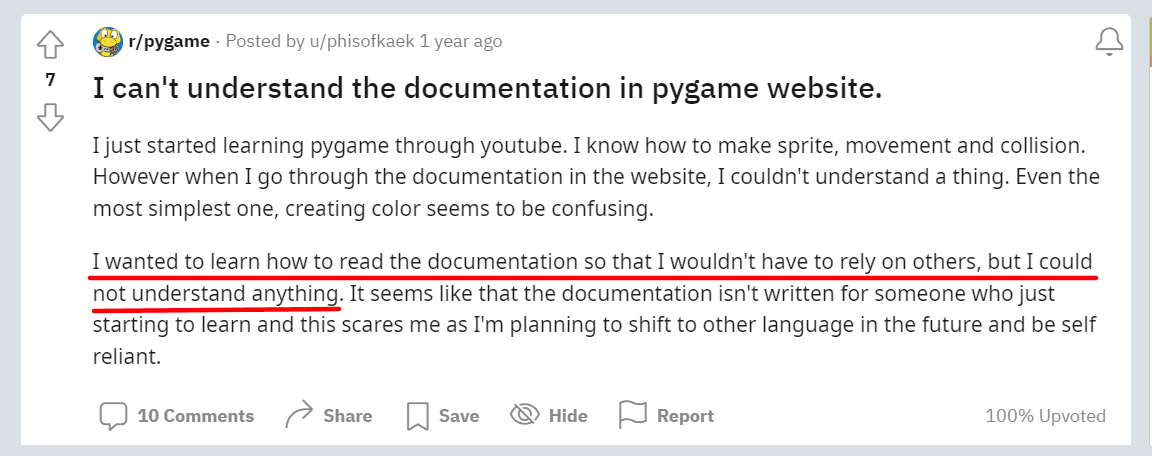
Source: Reddit
To achieve this high level of usability and accuracy, technical documentation needs to pass multiple rounds of review and editing to ensure that the documents can really serve their audience.
In the following sections, we’ll explain just how complex reviewing technical documents is and examine the resources and procedures needed for this highly collaborative task.
Stages of Technical Documentation Review
To keep your users happy with the product, your documentation needs to be spotless on multiple fronts.
It needs to be factually correct, linguistically accurate, and completely comprehensible to your users.
To satisfy all of these requirements, each document needs to pass a series of reviews administered by experts from different fields.
Let’s see how each of these review stages works.
1. Doc Team Review
The first round of reviews is usually handled internally by the technical writing team.
At this stage, a member of the technical writing team would examine your document, check it for any logical inconsistencies or inaccuracies and then test it for themself to see if they get the desired results by following the instructions in the document.
For example, if you wrote an installation guide, the reviewer would simply follow the steps exactly how you wrote them to install the product or feature.
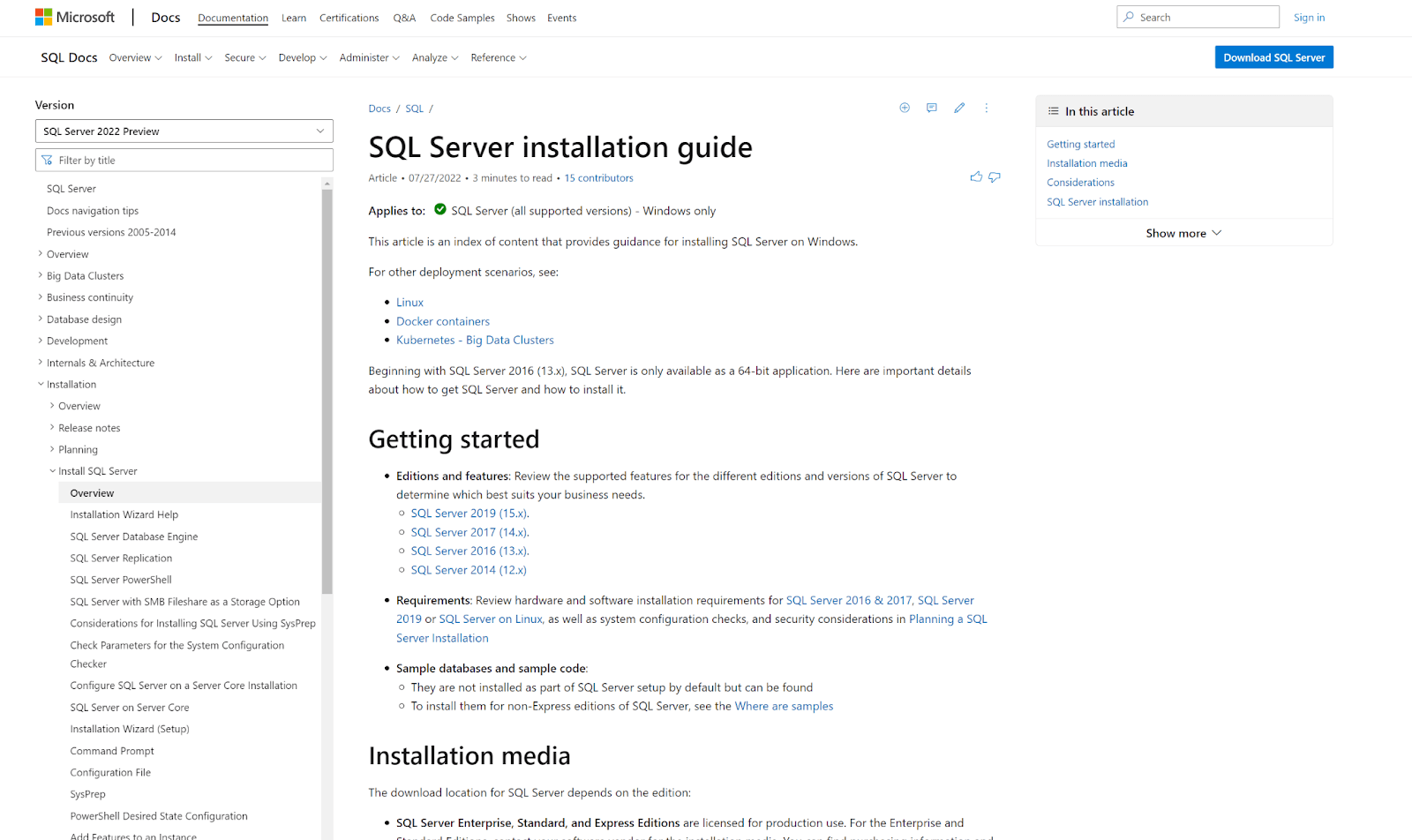
Source: docs.microsoft
After they’re done, your fellow technical writer would provide you with feedback on what needs to be clarified in the document, if there are any missteps in the document, and so on.
Apart from being a great first step for the review process, the doc team review stage is also a great opportunity for technical writers to learn from each other and exchange some good practices.
2. Product Team Review
This second stage of the review process is extremely important because it’s where your document is checked for factual correctness and accuracy of information.
Product team reviews are carried out by software developers or other people involved in the development of the product.
Their task is to check if the document is consistent with how the product works and if the instructions are in line with how the product team expects the user to interact with the software.
This stage can be a little tricky because those subject matter experts (SMEs) have other things to do (i.e. work on the product) besides reviewing your documentation so getting them to review your documentation may take some effort.
In fact, technical writers often say that getting SMEs to review their documentation is one of the most difficult parts of their job.
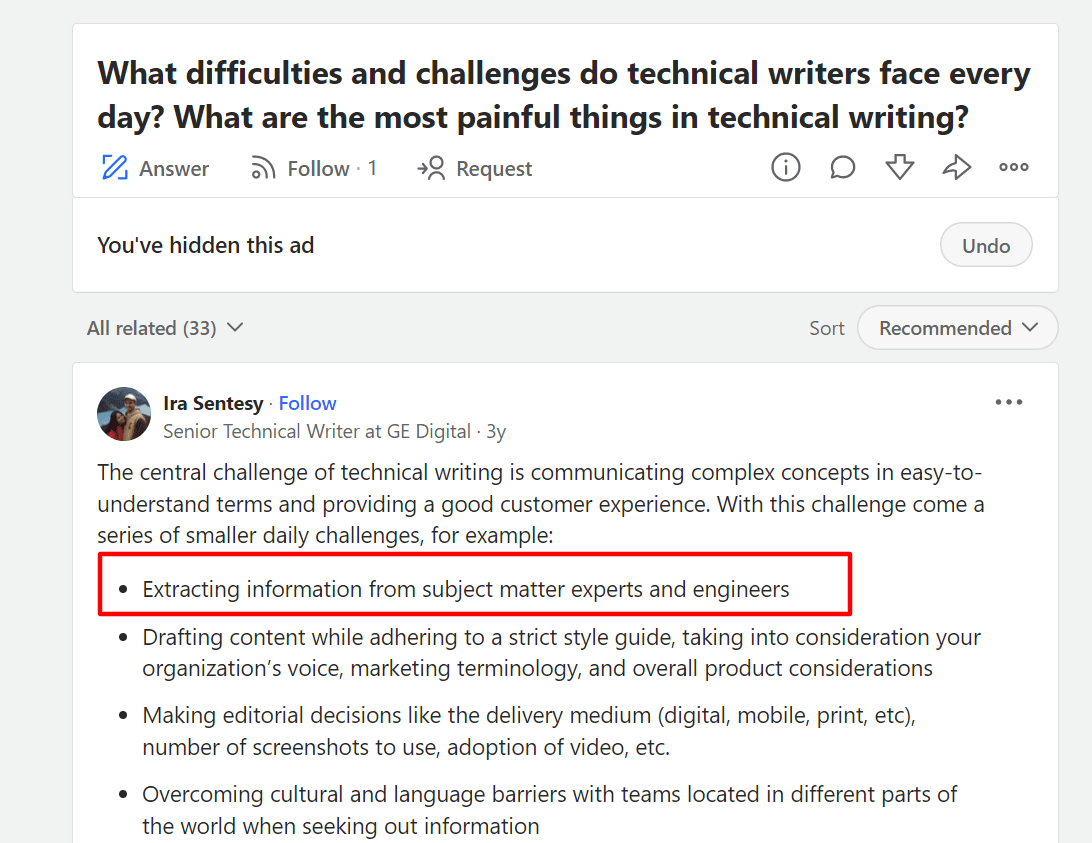
Source: Quora
Therefore, this is the part of the review process that might need a little more planning and a good amount of patience.
However, as we said, it’s a key step in the process and you should never skip it.
3. Field Engineers and Support Review
Field engineers and support staff are your teammates who work directly with the clients.
Their experience in handling user issues and problems is invaluable to technical writers, so they should definitely be included in the review process.
It’s easy to see why.
Support staff can review your documentation and tell you exactly which parts of it they predict users will have trouble with.
In those cases, they’ll recommend that you over-explain those parts to better support users when they get to that stage of their journey.
Similarly, these experts can tell you if there are steps in your documentation that are missing because you’ve assumed something is common knowledge in the technical documentation.
Field engineers and support staff can help you make your documentation more user-centric because they’re very familiar with your users and their habits, needs, and knowledge gaps.
4. Legal Team Review
Since your technical documentation will be used by a wide audience, precautions need to be taken so that your company is safe against legal action.
For instance, if the use of your product can in any way lead to personal injury or harm, it’s extremely important to have all the necessary warnings, disclaimers, and safety information in your technical documentation.
Software and hardware products in the fitness industry are a good example of this. The use of these products has health implications that need to be addressed.
Here’s how Polar handles this in the technical documentation for their smart wrist band and accompanying software.
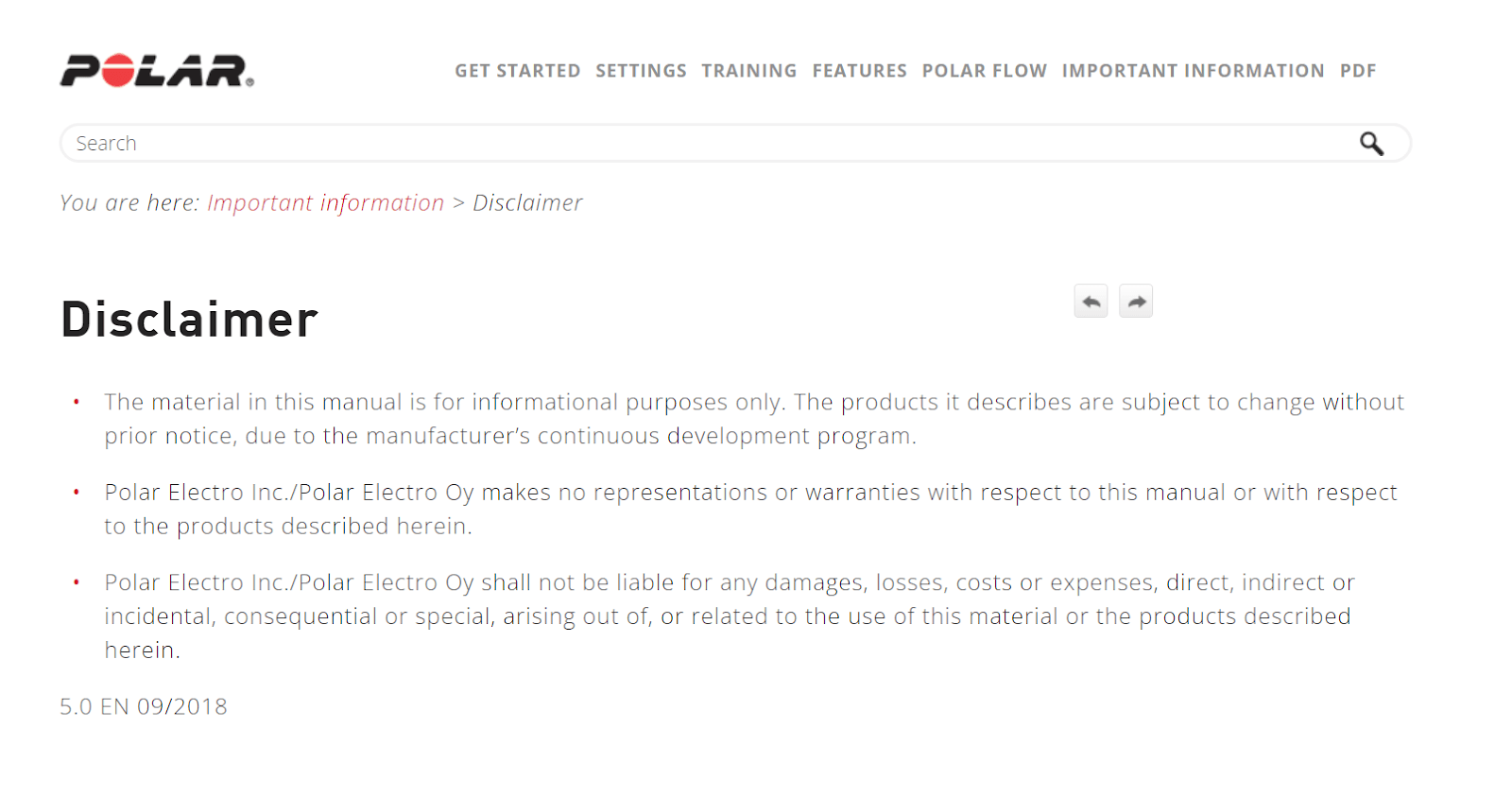
Source: Polar
The only experts at your company who can guarantee all legal requirements are being met are in your legal team, so make sure they have a look at your documentation and don’t publish it before they give their approval.
5. Beta Testers Review
Finally, it’s always a good idea to have people outside of the company test the documentation before it becomes available to the public.
A good way to do this is to have the documentation ready as soon as the product is ready for beta testing by early adopters.
In that case, you can release it along with the product and then ask your beta testers to provide you with feedback about the documentation while they’re giving feedback for the product itself.
This may seem a little redundant, but remember that your entire company is very familiar with your product because the whole team participated in creating it.
To make absolutely sure your documentation will be useful to your end-users, you’ll need testers who have zero experience with the product to follow the instructions and tell you if they found them helpful.
Priorities When Reviewing Different Technical Documents
As we said in the introduction, all documentation needs to pass some sort of review before it’s published. However, the review process isn’t the same for all types of technical documentation.
That’s because different types of documents are written for different audiences and carry different kinds of information.
In the following subsections, we’ll give you some examples of how technical documentation is reviewed to reach the highest standard of accuracy and usability.
User Manuals
The purpose of a user manual is to guide new users through the features and capabilities of a product. As such, it needs to be perfectly aligned with how a software product works.
In other words, ample testing and usability reviews are needed to ensure that this type of document is comprehensible enough for the end-user.
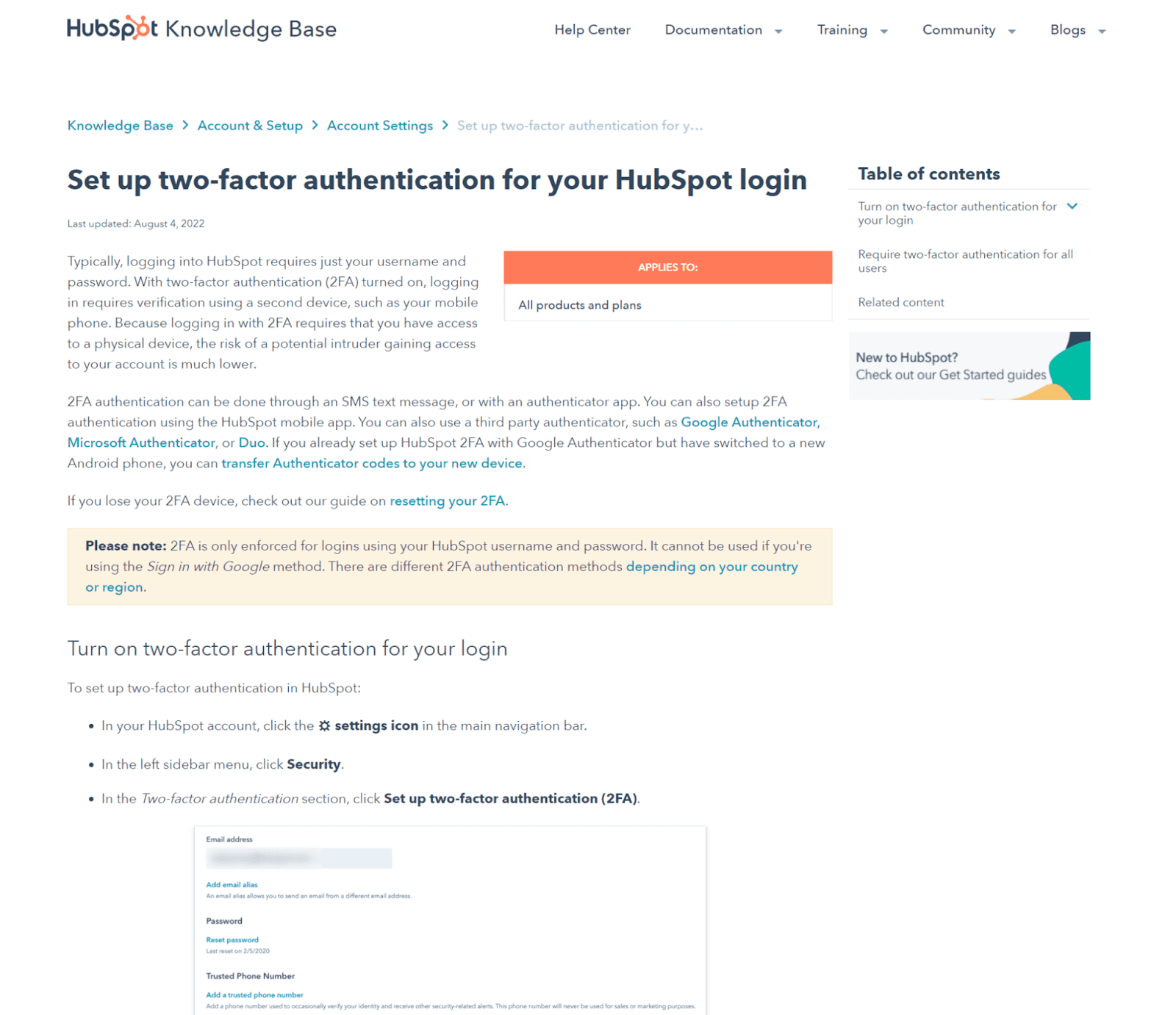
Source: knowledge.hubspot
As you can see from HubSpot’s example above, user manuals can get technically demanding, but the information within always needs to be presented in a way that’s easy to understand for any user, no matter their technical background.
That’s why reviewers of user guides should concentrate on simplifying complex information and providing users with an excellent user experience.
Coding Standards
Coding standards bring order and consistency to the team’s coding practices and ensure a high standard of code across the entire team.
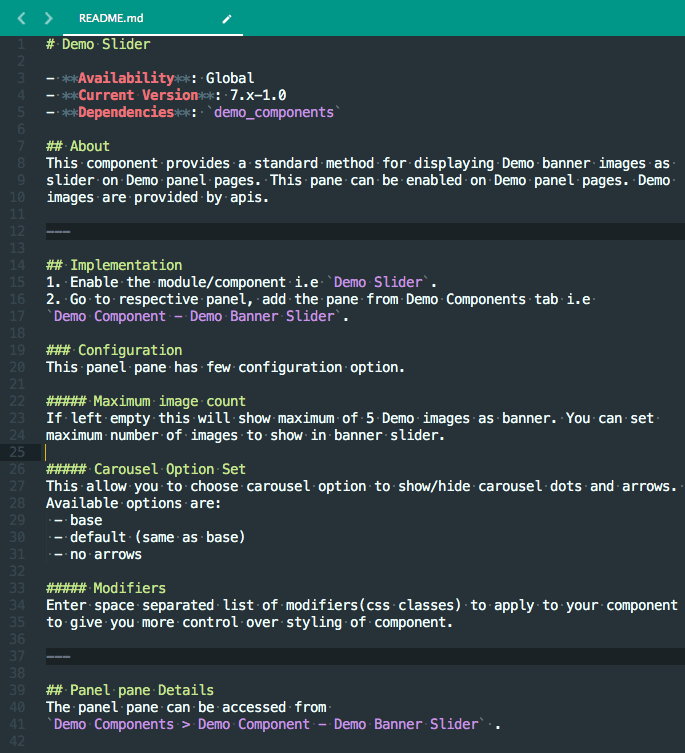
Source: Love Huria
In opposition to user manuals, coding standards are written by and for the development team working on software, meaning that the audience for this type of document has a high level of technical expertise.
Therefore, the final look and user experience for this document aren’t as important as with some other end-user-oriented documentation.
It’s the quality of information and the usability of the rules and regulations outlined in the coding standard that counts.
Everyone on the team should have equal say in what rules make the most sense, which information is redundant and can be removed, as well as a right to suggest improvements and additional rules that will help provide consistency and a high level of quality for the coding team.
Deployment Documentation
As far as audiences are concerned, deployment documentation lies somewhere between end-users and developers.
The primary audience for this type of documentation are developers, but those on the client’s side and not your internal team.
Accordingly, deployment documentation needs to have a high level of information quality, as well as a pristine look and user experience.
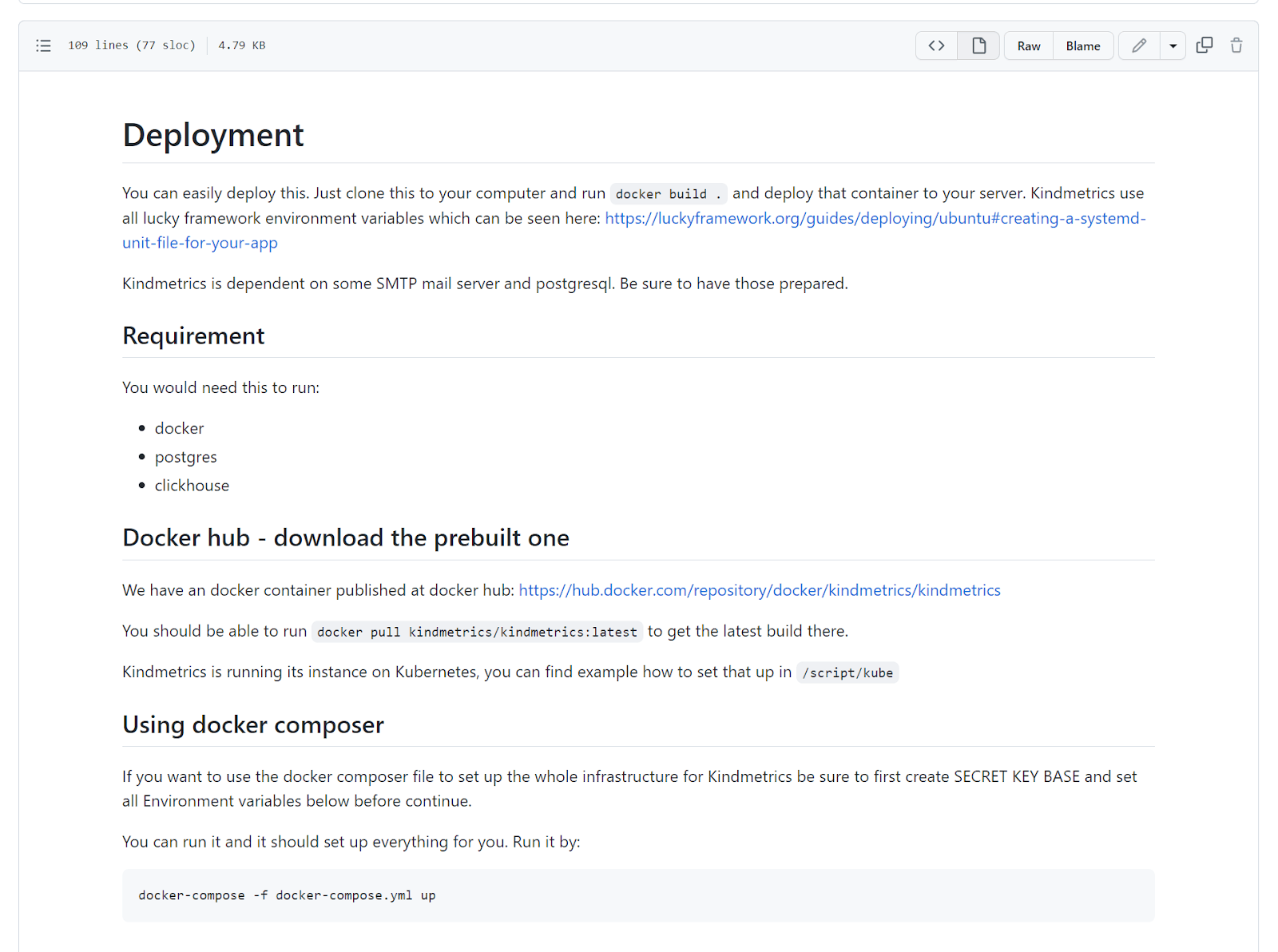
Source: Github
Reviewers should make sure that the document is rich with resources that are typically found in deployment documentation, such as:
- Deployment scripts and checklists
- Known issues and a troubleshooting guide
- Training resources for users who will be making the deployment
If all of the necessary information is there, reviewers can thoroughly test the documentation to see if it generates the desired results (successful deployment).
Simplification and readability aren’t as important for this document because its audience are developers with programming knowledge who require no intricate explanations.
Requirements Documentation
Requirements are an interesting type of document because their audience is the internal team, including stakeholders other than developers, such as business analysts, executives, and marketing and salespeople.
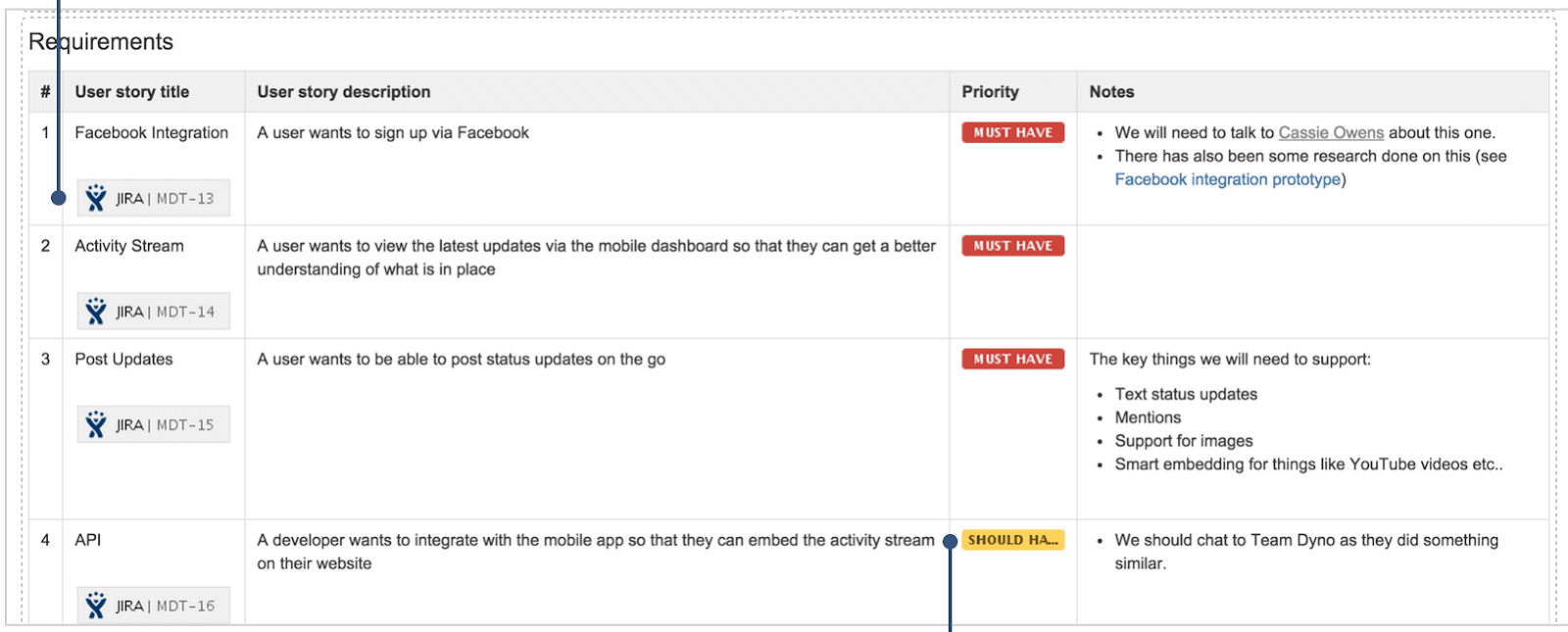
Source: uxbooth
An important issue reviewers should pay attention to is that requirements documentation is most often generated from user stories and feedback.
However, end-users don’t always know how to articulate their needs in a simple and accurate way, so the review should check the quality of information and avoid some of these problems:
- Contradicting requirements (when two or more customer stories produce requirements that can’t simultaneously exist in a single product.)
- Redundancies (the same request popping up in multiple places in the document.)
- Unclear requirements that have more than one explanation
- Design ideas masked as requirements (requirements documentation shouldn’t detail the design of the product, only define the needs that the future product will address.)
As you can imagine, reviewing requirements documentation involves a lot of cutting and simplifying, but the resulting document should help you design a great product more efficiently, so it’s worth the effort.
Tips for Improving Technical Documentation Accuracy
Now that we’ve given the proper definitions and enumerated the usual stakeholders in the process, as well as provided some examples of reviews for specific documentation types, let’s see what you can do to improve the accuracy of your technical documentation during the review process.
1. Develop a Technical Review Checklist
As we already learned, there are a lot of elements to a technical review, from spelling and grammar to factual accuracy and user experience.
To avoid leaving out anything important from the review process, it’s a good idea to codify it in the form of a review checklist.
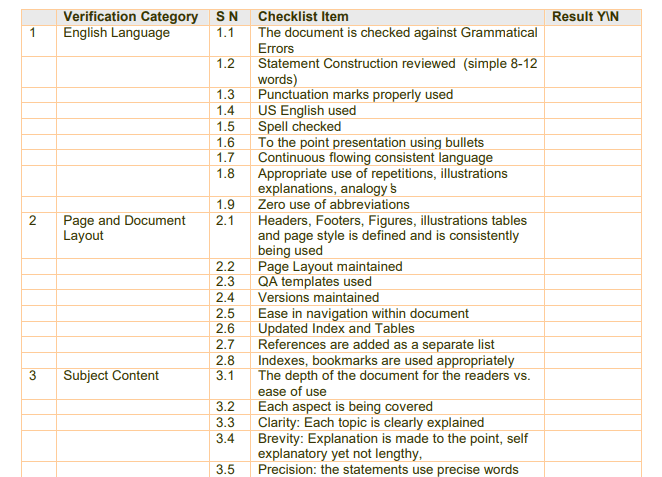
Source: Grey Cells
This kind of checklist will ensure all of your reviewers are on the same page and carry out their work according to a set of rules so that no document is mishandled.
It also allows reviewers and editors to focus better because they can take the review process step-by-step instead of analyzing multiple review elements at once.
2. Build Accountability Into the Review Process
Technical review is a vital part of the documentation process, but sadly, reviewers sometimes don’t take it seriously enough.
This is especially true for reviewers whose primary job isn’t documentation and review, such as SMEs responsible for ensuring documentation is factually correct and accurate.
The only way you can ensure the review process is carried out to the fullest capabilities of your team is to make said team accountable for it.
If you’re using quality documentation software, that should be easy enough.
For example, Archbee has a Document History feature that allows you to see exactly which changes were made to the document and by whom.
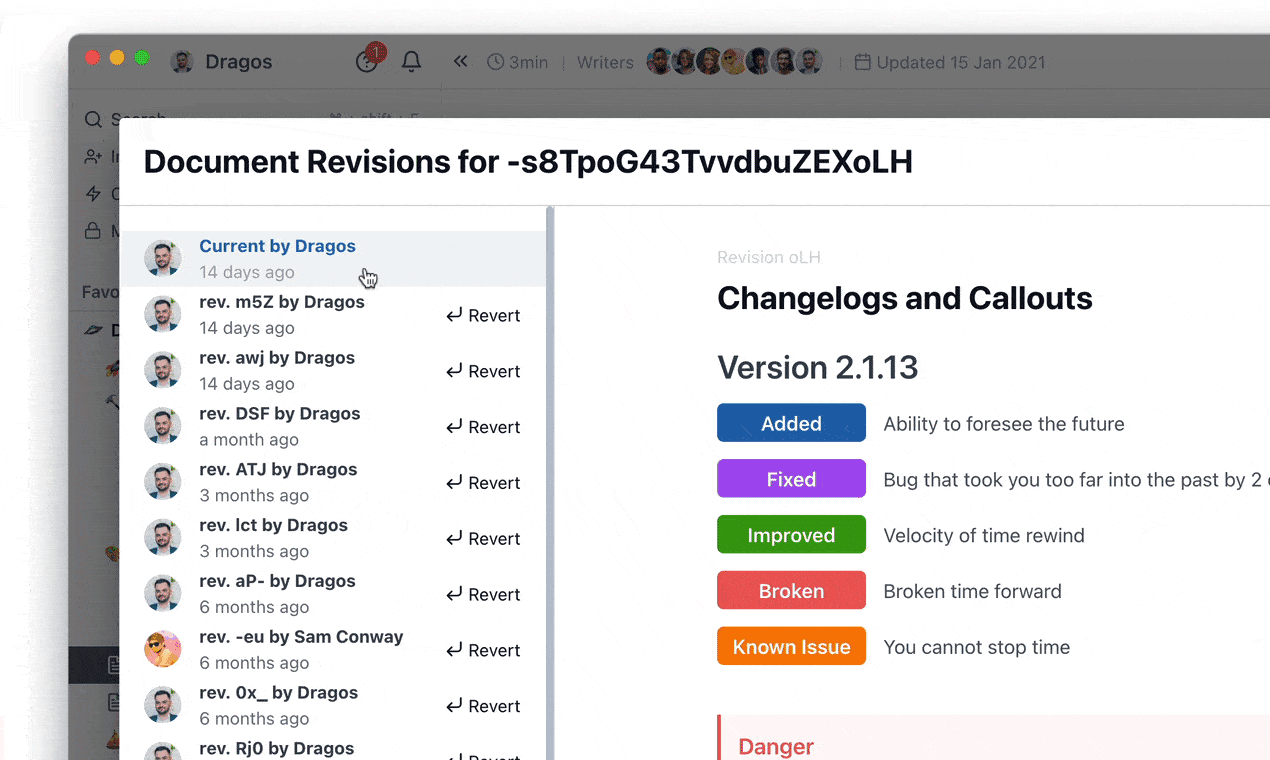
Source: Archbee.com
With their name attached to the document in the changelog, every stakeholder in the review process is accountable for their own work.
3. Raise the Accuracy Bar for Technical Writers
Technical writers cannot be expected to do a good job with documentation if they’re locked out of the product and can’t access vital information they need to write accurate documents.
The solution to this is to involve the writers in the development process and allow them to learn as much as possible about the product they’re documenting.
There’s more than one way of going about that:
- Let writers sit in scrum meetings.
- Provide them with access to the product as it’s being developed.
- Facilitate meetings and interviews between writers and developers so that writers can collect the information they need.
Technical writers are important stakeholders in the product development process, so don’t shut them out.
Provide them with access to experts and the product so that they can write more accurate documentation that requires less review.
4. Make Reviews a Higher Priority for Developers
As we said, developers and other subject matter experts are crucial for the review process because they have the most direct knowledge and experience with the product.
Only after they’ve approved the documentation can you be sure it’s going to be useful to your customers.
Accordingly, it makes sense to make review responsibilities a priority for developers. Again, good documentation software can help.
For example, Archbee lets you tag experts on the document and notify them that they need to verify the doc before it can be published.
Source: Archbee on YouTube
With a document verification option, developers will know that a document cannot be published without their say-so, which will let them know that review should be a priority task and something they cannot skip if they don’t want to hold up the entire process.
Technical Documentation Review Mistakes to Avoid
Technical documentation reviews always carry a risk of error. In the next few subsections, let’s examine the most common mistakes technical reviewers make and arm you with strategies to avoid them. Here are also two article about common mistakes in writing technical documentation and documentation mistakes developers should avoid.
1. Incomprehension of the Review Process
A chaotic review process won’t help you produce quality, accurate documentation.
If your reviewers don’t understand how reviewing works for your project, they won’t be able to align the documentation with its appropriate audiences nor guarantee that the information in the documents is accurate and correct.
So, if you haven’t already, take the time to codify and define every step, stakeholder, and deliverable in the documentation review process, and then share it with the people tasked with reviewing the documentation.
Only with a well-defined review process everyone is familiar with can you consistently produce quality documentation to serve your users.
2. Inappropriate Review Participants
In an inefficient review process, documents are over-edited by experts of the same type, while also not getting enough attention from reviewers of other backgrounds.
A common scenario where this mistake happens is not getting any input from the actual users of the product and documentation.
Instead, the reviewers of the documentation are often only the people that are too close to the project and can’t accurately pinpoint the parts of the documentation users are struggling with.
An easy fix for this mistake is to implement systems for catching user feedback, such as a comments section under every article.
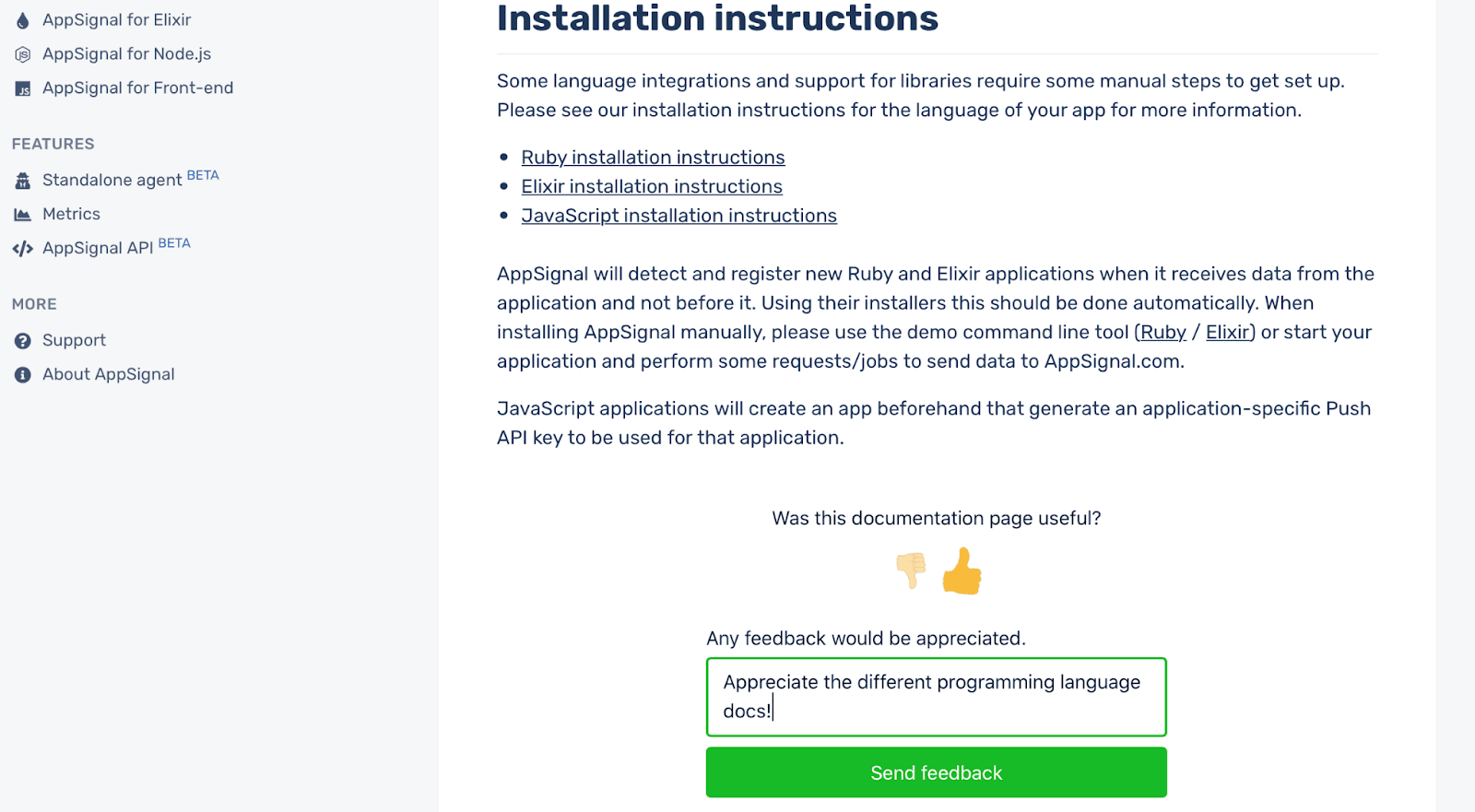
Source: Freddy Feedback
Remember, your review process needs to include a variety of perspectives to cover the documentation from every angle.
Make sure that your documentation is reviewed by the right people who can make it more accurate and useful for your end-users.
3. Focusing on Style Instead of Substance
Guidelines on style are present in almost any technical writing manual you’ll ever use as a writer. There’s no question that style is an important part in writing technical document.
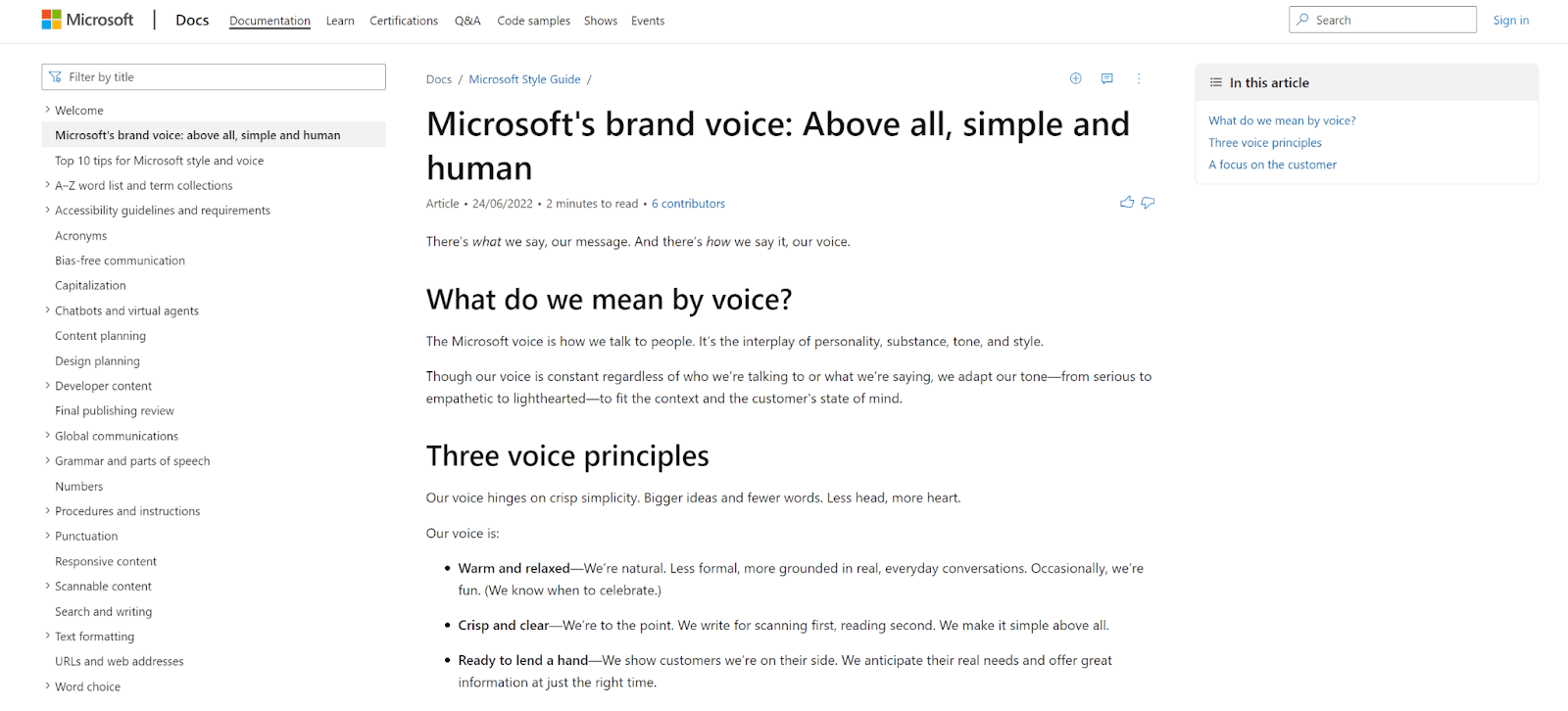
Source: docs.microsoft
However, you should also keep in mind that the primary purpose of technical documentation is to educate users, not delight and entertain them.
Therefore, if reviewers become too focused on the stylistic choices of writers, greater mistakes could slip by unnoticed.
That’s because reviewers will start losing sight of the bigger picture and waste time fixing stylistic mistakes that don’t actually take away anything from the user experience.
One way to avoid this mistake is to instruct your reviewers to focus on the content of the document instead of the style and provide a copy-editor to take a last look at the documentation before it’s published.
Conclusion
This guide to technical documentation reviews has given you a starting position in developing your own review process by showing you how reviews work, who the stakeholders are, and what you should and should not do to ensure a smooth and accurate review experience for everyone involved.
However, every development and technical writing team is different, so feel free to work your own elements and company character into the process.
Remember, technical documentation is only useful when it’s accurate and easy to understand, so give the documentation review process the attention it deserves.
FAQ
Frequently Asked Questions
A technical documentation review is a structured, multi-step evaluation of docs to ensure they’re accurate, clear, complete, and usable for their intended audience. Reviewers validate facts against the product, follow the procedures end to end, and check that language, visuals, and structure help users complete tasks without confusion. What it typically covers: - Accuracy: instructions match current product behavior and terminology. - Clarity and completeness: steps, prerequisites, and outcomes are unambiguous. - Usability: navigation, formatting, and examples support quick task success. - Risk and compliance: warnings, licensing, trademarks, and privacy language are correct. - Consistency: style, tone, and nomenclature are aligned across docs. It’s collaborative by design, involving technical writers, product SMEs, support/field teams, legal, and often beta users. The outcome is a verified document that helps users succeed confidently and safely.



